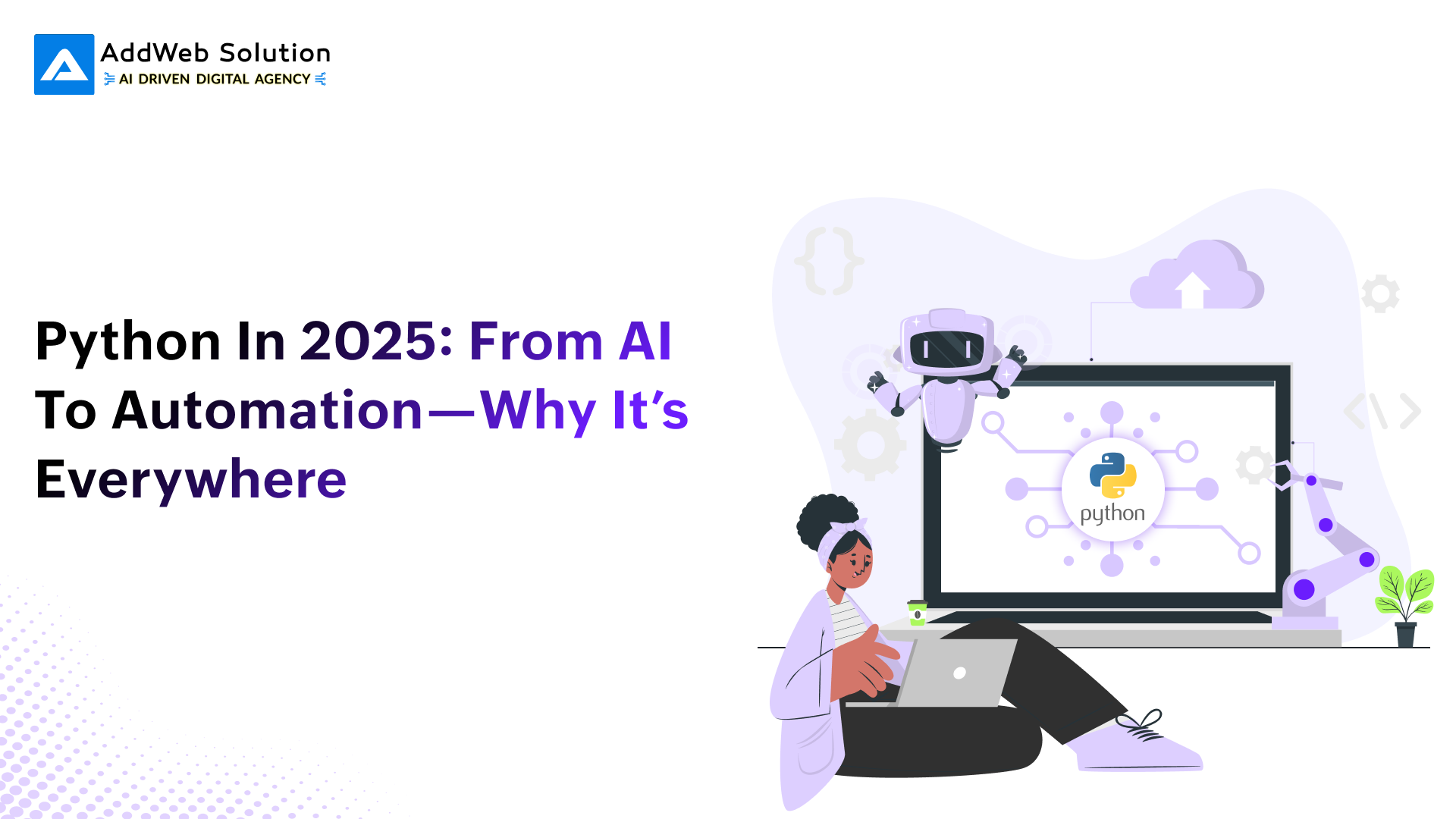Python in 2025 is everywhere. Not just for nerds in hoodies typing away in dark basements, either. We’re talking AI, robots, your phone, probably your fridge too (if it’s one of those fancy smart ones). It’s like the duct tape holding the digital world together.
And yeah, Python’s been around forever. So why hasn’t it faded into tech oblivion, replaced by something trendier?
Simple answer: it just works. The syntax is cleaner than my kitchen on inspection day, there are so many libraries it’s honestly overwhelming, and you don’t need a PhD to pick it up.
Grandma could build a chatbot with it if she wanted.
But the real kicker? It’s not just for coders. Designers, scientists, bored teenagers—everyone’s using Python for literally everything: web apps, machine learning, hacking stuff (legally, I guess), running IoT gadgets, the whole nine yards.
It’s 2025, and Python’s not going anywhere. If anything, it’s just getting cozier at the top.
Python in 2025: More Than Just a Language
So, here we are, halfway through the 2020s, and Python? Still crushing it. It’s not just hanging on—it’s everywhere. Python’s sitting right at the top, flexing as the most-used language on the planet.
Over a million developers? That’s not a small club. That’s a small country of people writing Python day in, day out. Whether it’s powering the boring stuff behind giant companies or popping up in kids’ coding classes, Python’s got its fingers in everything.
Startups love it for whipping up prototypes in, like, a weekend. Data geeks are obsessed with it—giant piles of data? No sweat.
Security folks use it to poke holes in systems (all ethical, of course), and teachers keep bringing it out as the “hello world” starter kit for newbies. Python’s the universal remote of programming right now.
The Roots of Python’s Enduring Popularity
Python keeps crushing it because it somehow manages to be dead simple and wildly powerful at the same time. The syntax?
It’s like reading plain English, so newbies don’t get scared off, but it’s got enough muscle under the hood that pros can whip up some seriously complicated stuff if they want. And don’t even get me started on the libraries—there’s a plug-in for everything.
And, look, the community is half the magic. You run into a wall? Someone’s already posted about it on Stack Overflow, or maybe there’s a GitHub repo with the exact thing you need.
Even YouTube is drowning in tutorials—some better than others, but hey, free advice!
Doesn’t matter if you’re a grizzled coding veteran or just poking around for the first time, you’re never really alone with Python. It’s like having a whole crowd cheering you on, or at least yelling helpful suggestions from the sidelines.

Python and Artificial Intelligence: A Perfect Match
Python pretty much eats the AI world for breakfast—no contest. Everywhere you look these days, AI is butting into daily life.
Your Netflix picks? AI. That “smart” speaker that sometimes answers the wrong question? Yep, AI again. And what’s running the show behind the curtain? Python.
I mean, these libraries—TensorFlow, PyTorch, Scikit-learn—make spinning up gnarly AI models almost… boringly easy.
Then you’ve got stuff like spaCy and Hugging Face Transformers, so anyone with a laptop can mess around with chatbots or set up apps that can tell if your tweets are salty or sweet. Python is the backbone here, not just some random sidekick.
And let’s be real: if you’re an AI engineer or data scientist in 2025 and you’re not using Python, are you even working?
People are cranking out prototypes and then flipping them into full-blown products, all in the same language, no sweat. Plus, Python just slides right into whatever else you’re using—cloud stuff, databases, analytics—like it was made for it. Honestly, good luck finding something more essential in this space.
Driving Automation in the Modern Era
If you’re not automating stuff by 2025, you’re living in the digital stone age. Everyone’s in on it—businesses, content creators, even your neighbor who still types with two fingers. Automation’s not some fancy add-on anymore. It’s just how people get through the day without losing their minds over boring, repetitive junk.
And Python? Yeah, it’s the Swiss Army knife for this whole scene. Wanna blast out a bunch of emails, organize files you haven’t touched since 2012, scrape websites for info, or make your daily workflow less of a dumpster fire?
Python’s got you covered. It’s everywhere. DevOps folks lean on it to wrangle servers and keep logs from turning into chaos. Meanwhile, marketing teams are out here using Python scripts to spam—er, I mean, “strategically schedule”—social media posts and scoop up new leads without lifting a finger.
Plus, it plays nice with low-code tools like Zapier and Google Apps, so even if you’re allergic to code, you’re not left out.
The kicker? You don’t need to be some code wizard with twelve monitors and a caffeine problem. Python’s so chill that even marketers, analysts, and admin types can jump in and start automating. Stuff that used to be locked behind a wall of nerd jargon? Now it’s just another Tuesday.
Python’s Role in Modern Web Development
Web devs’ gone wild over the years, but Python? Still holding its own, especially when you’re talking backend magic. Django’s like that reliable friend who just gets stuff done—super handy for cranking out sites fast and keeping your data locked up tight. FastAPI?
That thing’s like the new kid who’s already running laps around the old guard, especially if you’re into slick REST APIs.
It’s wild how Python’s sneaking into frontend turf now, too. You got stuff like HTMX and PyScript letting devs do all sorts of tricks—basically, you don’t even have to break up with your favorite language to make cool, interactive stuff.
Why does everyone from startups in their garage to corporate behemoths keep picking Python?
Simple: it gets your project live faster, keeps the headaches to a minimum, and the code doesn’t turn into unreadable spaghetti after a few months. Clean, quick, and you don’t need to sell your soul to get something maintainable. Not bad, right?
Python’s Emerging Role in Cybersecurity
Python’s the Swiss Army knife for cybersecurity geeks. Folks in the trenches?
They’re whipping up Python scripts left and right—digging for weak spots, poking at malware, automating those boring-but-crucial security checkups. It’s like, “Oh, you need to scan a network or mess with some weird protocols?”
There’s probably a Python library for that. Scapy, Volatility, Impacket—those names ring a bell for anyone who’s ever done some deep packet diving or memory poking.
Ethical hackers love Python because it’s fast, flexible, and makes life easier when you’re building sneaky little tools. SOC teams are cramming Python scripts into their SIEM setups, so they catch the bad stuff as it happens.
It’s not just about defending, either—Python helps you get how cyber threats tick, which is half the battle. At this point, if you’re serious about cyber defense and you don’t have Python in your toolbox, what are you even doing?

Get Scalable Python Solutions Tailored for 2025 and Beyond

Pooja Upadhyay
Director Of People Operations & Client Relations
Python in IoT and Hardware Programming
So, back in the day, folks would just laugh if you suggested Python for embedded stuff—like, “Yeah, right, Python’s for desktops, not tiny chips!” But, honestly, that ship has sailed.
MicroPython and CircuitPython? Total game-changers. Now you can slap Python onto a microcontroller and go nuts building all sorts of IoT gadgets.
Setting up hardware prototypes with Raspberry Pi, Arduino, or ESP32? Python’s your buddy. You can whip up prototypes or wrangle sensor data without losing your mind over cryptic C code.
Python’s turned into this magic handshake between hobbyists soldering stuff in their garage and hardcore IoT engineers doing the real deal. It’s like the universal translator—everybody speaks Python now, whether you’re lighting up LEDs or building self-driving coffee machines.
Python for Education and First-Time Coders
Walk into any high school, college, or bootcamp and—boom—Python’s front and center. It’s like the “Hello World” of modern education.
Why? Well, it doesn’t beat you up with cryptic symbols or weird rules. The code looks almost like plain ol’ English, so you don’t spend half your time smashing your head against the wall trying to figure out what a semicolon did wrong this time.
You want to whip up a calculator app? Sure. Build a weird little game powered by AI? Go for it. Python’s got your back, and you’ll see stuff working fast, which is honestly half the battle when you’re starting. That little hit of “Wow, I made this!” keeps you coming back for more.
And let’s be real, by 2025, Python isn’t just some handy trick to toss on a résumé. For a lot of folks, it’s the on-ramp to jumping into anything digital. If you’re not on the Python train yet, you might wanna grab a ticket.
What the Future Holds: Python Trends in 2025
Python is the go-to tool for anyone wanting to mess around with AI, whether you’re fine-tuning your chatty robot or slapping together some app that feels like something out of a sci-fi flick. Even web browsers are getting in on the action.
And hey, if you’re tired of babysitting servers, the cloud giants like AWS and Google Cloud have your back. They’re rolling out more ways to run Python code on-demand—no servers to hug, no late-night panic attacks over downtime.
Python’s not just about chasing shiny new tech. It’s getting pulled into the whole “let’s make AI less sketchy” movement—stuff like fairness, privacy, and making algorithms less of a black box. So, it’s not just the nerds winning here; society gets a little boost too.
Honestly, with all the crazy stuff happening—edge devices, AR, automation—Python’s like that friend who somehow fits in everywhere. Can’t see it fading out anytime soon. If anything, it’s just getting started.
Conclusion
Python’s glow-up is wild when you think about it. What started as this scrappy little side project is now basically holding the internet together in 2025. AI, bots, websites, classrooms—it’s everywhere.
The best part? It just makes sense. No headaches, no jumping through hoops, just pure “get stuff done” energy. The community is stacked, the libraries are endless, and it’s both chill for newbies and a beast for pros.
Doesn’t matter if you’re poking at your first “hello world” or cobbling together some mind-reading AI, Python’s your trusty sidekick. It’s not just another tool—it’s the backbone.
And yeah, at AddWeb Solution, we squeeze every last drop of awesome out of it to help businesses get ahead, not just keep up.

Power Your Next Big Idea With Python Experts by Your Side

Pooja Upadhyay
Director Of People Operations & Client Relations

